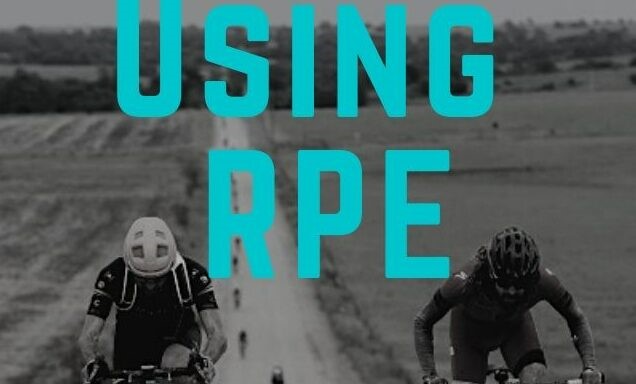Rate of Perceived Exertion (RPE), otherwise known as FEELING, is used to help athletes, including cyclists and runners, and their coaches understand how hard an effort OR a workout feels to the athlete. There are no wrong answers but it is important that athletes and coaches ‘calibrate’ their RPE scales so that they can communicate effectively and track their workouts in a way that leaves room for truely maximal days.
The Two Types of RPE in Training
There are two types of RPE so it can be confusing how they relate.
- RPE during a workout/effort (how hard are you working right now?)
- Session RPE (sRPE) to record how hard a given workout was after you finish it.

At Mile 75 in the 200 mile Unbound Gravel Cycling Race – How hard are these athletes working?
RPE During a Workout – How hard are you working right now?
For most athletes this could be as simple as having 3 ‘zones’ – Easy, Medium, Hard but you will also see RPE as a scale of 1-10
How hard something feels WHILE YOU ARE DOING IT can be affected by heat, altitude, how long you have been riding/going hard. Using the image above as an example, at 75 miles into Unbound gravel. That hill would be very easy if you were only 2 miles in but how would it feel at 75 miles, or 199miles into a ride? You might say that it would be easy (1-4) early in a ride, moderate (4-6) at 75 miles and then Hard (10/10) as you finish and collapse at the finish after 200 miles.
Get a Training Plan based on RPE / Feeling.
Feeling (RPE) is independent of Heart Rate and power depending on the context and environment.
Similarly, if you are doing a set of 3 x 10 threshold intervals you are going to be constantly reflecting on how hard you are going. Is your breathing elevated? Does it feel like you will just get to the end of the 10 minutes? As you do more interval training and racing this ‘feeling’ for what is sustainable for a distance/time becomes more refined. You become better at pacing.

Example of RPE scale you could use during an effort, workout or commonly during Vo2/Ramp tests
Session RPE (sRPE) – How Hard was that ride you just finished?
I use this with clients to reflect on how hard a workout was. There are no wrong answers for sRPE. It may be higher than expected if it is hot out or you are tired from other workouts or just stressed from work. Fueling errors (too little carbohydrate or calories) before, between or during workouts can create a much higher RPE for the same workload.

Training Peaks offers a spot to reflect on ‘how hard was the workout’ and also use smiley/sad faces for how you felt
In general, we see endurance rides done 2-4 / 10 and intensity days 7-9 rep. Many people agree with this in theory but then will train in the middle (4-6) most days. This is the mistake of the ‘middle-ground’ or ‘black hole’ training. These athletes never go easy and rarely go really hard.
Days that are 9-10 are generally reserved for big race days or key workouts in your training. This could be your A-race for the year where you collapse at the finish line and can’t do anything the rest of the day or after a personal best 20 minute time trial where you collapose at the finish and can’t do anything the rest of the day. The ‘can’t do anything the rest of the day’ and more obvious signs of ‘failure’ or ‘fatigue’ such as cramping, vomitting or bonking might help guide when a workout has reached the 10/10 status.
NO PAIN, NO GAIN?
Athletes can make the mistake of going to the point of vomiting, being completely ‘knackered’ too often in an attempt to work harder than others, or in the ‘no pain, no gain’ mindset. Again this results in poorer results as injuries/burnout or extended recovery result.
Aim for a couple of focused 7-9 RPE a couple of times a week takes discipline but when coupled with lots of work in the 2-4/10 range will create a fun and sustainable plan that creates great fitness.

Example of a Session RPE scale – there is a lot of room to interpret — watch the middle ground
Still confused? Book a call to chat out how to best use RPE in your training.





